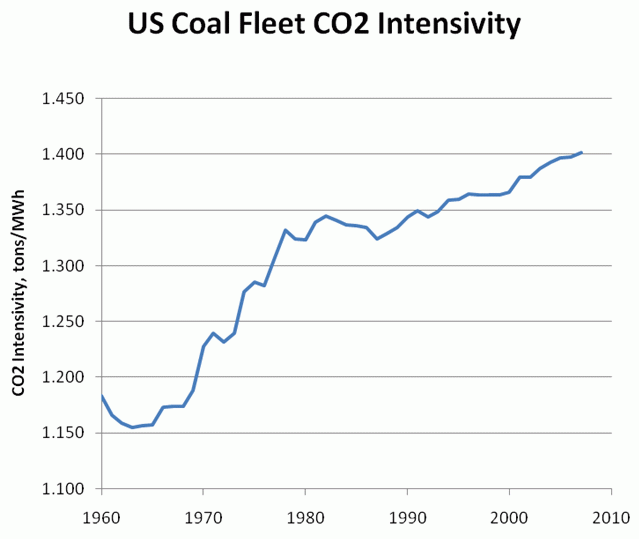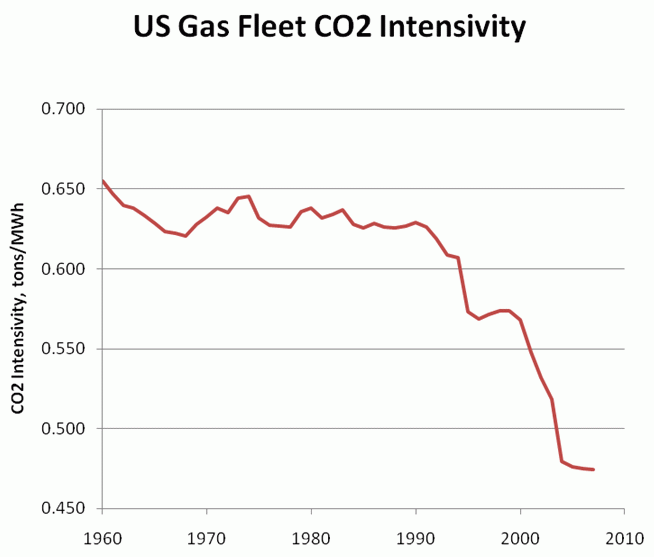It was the best of half-centuries, it was the worst of half-centuries …
Broadly speaking, there are only three things we can do to lower CO2 emissions: switch fuels, use energy more efficiently, or use less energy (conserve).
Our CO2 conversations too often focus on one of those three in isolation: Coal bad. Recycled waste heat good. Conservation isn’t an energy policy. Each assertion is both narrowly true and broadly incorrect, to the extent that each simplifies three prongs into one.
To understand why, try to answer a simple question: if we shifted our power generation fleet to preferentially dispatch natural gas plants instead of coal plants, how much would CO2 emissions fall?
That would seem to be an easy bit of math: just measure the CO2/MWh of each plant, multiply the difference by the MWh switch, and we have our answer, right? Turns out it’s a tad complicated, for the simple reason that the fuel switching strategy is also an efficiency strategy. Does a newly dispatched gas plant look like one of the old, 30% efficient, natural gas-fired Rankine “steamers,” or does a newly dispatched gas plant look like one of the new, 50% efficient combined cycle gas turbines? What about the coal plant that gets turned off?
Better still, let’s ask an easy question: how has the CO2 signature of our nation’s coal and gas-fired power fleet changed with time?
DOE/EIA keeps voluminous records of fossil fuel consumption and power generation by fuel type. On the following charts, I’ve divided total fleet fuel use by total fleet MWh and then multiplied by a consistent 0.06 tons of CO2/mcf of natural gas / 2.7 tons CO2/ton of coal to yield the following:
Interesting. From 1960-1990, there was no statistically significant change in gas fleet CO2 emissions, which held steady at 0.63-0.65 tons/MWh. Then all of a sudden in the 1990s, the fleet transformed itself, reducing its CO2-intensivity by 25% in just 10 years. What happened?
In a word: competition. The introduction of competitive access in the 1992 Energy Policy Act (and subsequent FERC rulings) brought forth a flood of natural gas plants, many of which were nearly twice as fuel efficient as the old junk that the grid had previously relied on. Prior to that point, costs were simply something that you passed along to customers. After that point — for much of the grid — cost control was a route to greater profits. Not surprisingly, generator owners suddenly got religion on cost-control. And when your number one cost is fuel, that means they got religion on fuel control. That’s good.
Now let’s look at what happened to the coal fleet during the same period:
From 1960-1970, the coal fleet holds steady at 1.17 tons/MWh, but then starts an inexorable upward trend. While the gas fleet became more efficient with time (after 1990, at least), the coal fleet is steadily less efficient. Way less in fact — to the point that the CO2 emissions associated with a MWh of coal-derived electricity are 18% higher today than they were in 1960.
What happened here? Two things:
1. Unintended consequences. 1970 saw the passage of the Clean Air Act, a deeply flawed bill. It was good in terms of what it did for regulated pollutants, but lousy in terms of what it did for unregulated ones (e.g., CO2). By effectively mandating pollution control approaches that impose parasitic loads on coal plants, the CAA is directly responsible for lowering coal plant energy efficiency, so that we now burn way more coal per MWh than we did before passage. We therefore emit way more CO2 per unit of useful electricity. That’s not to ignore the beneficial elements of the CAA, from sulfur to particulate control, but simply to point out that an environmental regulation that encourages energy inefficiency leaves much to be desired.
2. Dispatch considerations. As noted here, the last 30 years have seen virtually no construction of new baseload power plants in the US, but have seen a steady increase in the annual load factor of currently existing baseload plants. In other words, plants that used to spend most of their life turned off now spend most of their life turned on. In the coal fleet, that means that the least efficient stuff runs more now than it used to. So in addition to the unintended consequences of the Clean Air Act, we also have the simple fact of steadily growing electricity demand that causes us to pull our power from ever-more-undesireable sources.
Why didn’t the competitive forces unleashed by the 1992 EPACT also drive up the efficiency of our coal fleet, like they did for gas? Again, it’s an easy answer: competition. Coal plants are lousy investments. No one builds them who has to put their own money at risk.
One last thing
Here’s the tragedy: If we had run the gas fleet at a constant fuel efficiency from 1960-present, we would have emitted an additional 1.3 billion tons of CO2 into the atmosphere. That’s 1.3 billion tons not in the atmosphere today thanks to energy efficiency.
On the other hand … if we had run the coal fleet at a constant fuel efficiency from 1960-today, we would have emitted nearly 9 billion fewer tons of CO2 into the atmosphere over the last fifty years.
1,300,000,000 steps forward, 9,000,000,000 steps back.





